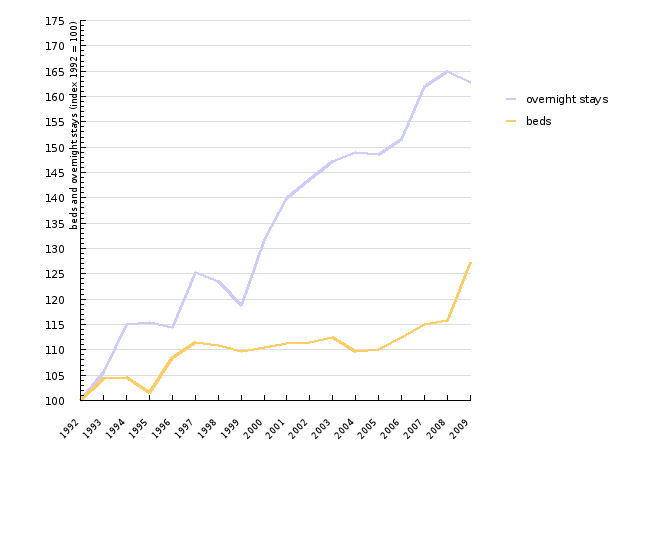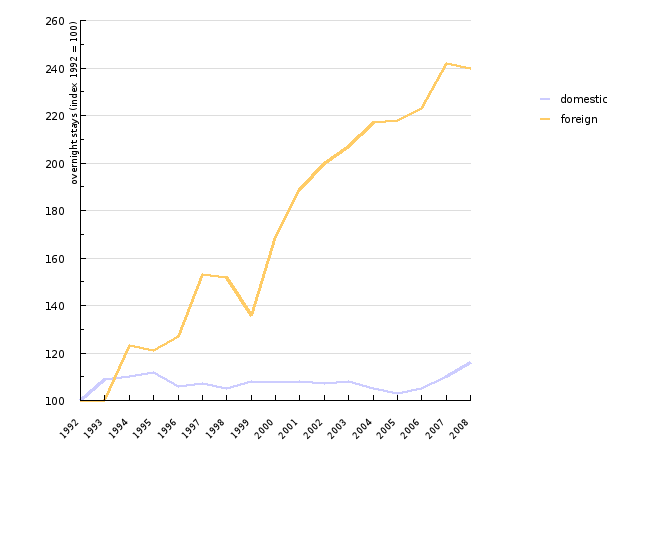[TU01] Development and distribution of tourism

Key message

The number of available beds and of overnight stays, in particular, have been growing constantly during the period in question (1992-2009). Tourist bed occupancy rates were highest during the summer months, when the majority of tourists visit seaside tourist resorts, with a slightly smaller share visiting mountain and health resorts. During the winter season, health resorts record the highest number of overnight stays.
Definition
The indicator shows the development of tourism in Slovenia with the trends in the number of available beds and the number of overnight stays of tourists, as well as their temporal and spatial distribution, primarily with regard to the type of tourist resort.
Charts
Statistical Yearbook RS 1996-2002, Statistical Office of the Republic of Slovenia; SI-STAT, Statistical Office of the Republic of Slovenia, 2010
| 1992 | 1993 | 1994 | 1995 | 1996 | 1997 | 1998 | 1999 | 2000 | 2001 | ||
|---|---|---|---|---|---|---|---|---|---|---|---|
| overnight stays | index (1992 = 100) | 100 | 106 | 115 | 115 | 114 | 125 | 123 | 119 | 132 | 140 |
| beds | index (1992 = 100) | 100 | 104 | 105 | 102 | 108 | 111 | 111 | 110 | 110 | 111 |
| overnight stays | number | 5097973 | 5384626 | 5865608 | 5883046 | 5832244 | 6384062 | 6295308 | 6056563 | 6718998 | 7129602 |
| beds | number | 71761 | 74825 | 75003 | 72853 | 77803 | 79949 | 79504 | 78746 | 79225 | 79893 |
| 2002 | 2003 | 2004 | 2005 | 2006 | 2007 | 2008 | 2009 | ||||
| overnight stays | index (1992 = 100) | 144 | 147 | 149 | 149 | 151 | 162 | 165 | 163 | ||
| beds | index (1992 = 100) | 112 | 112 | 110 | 110 | 113 | 115 | 116 | 127 | ||
| overnight stays | number | 7321061 | 7502569 | 7588737 | 7572584 | 7722267 | 8261308 | 8411688 | 8302231 | ||
| beds | number | 80034 | 80724 | 78654 | 78960 | 80737 | 82515 | 83157 | 91332 |
SI-STAT, Statistical Office of the Republic of Slovenia, 2010
| 1992 | 1993 | 1994 | 1995 | 1996 | 1997 | 1998 | 1999 | 2000 | 2001 | ||
|---|---|---|---|---|---|---|---|---|---|---|---|
| domestic | number (in mio) | 3.083 | 3.372 | 3.385 | 3.448 | 3.282 | 3.306 | 3.233 | 3.315 | 3.315 | 3.316 |
| foreign | number (in mio) | 2.015 | 2.012 | 2.481 | 2.435 | 2.551 | 3.078 | 3.062 | 2.741 | 3.404 | 3.813 |
| domestic | index (1992 = 100) | 100 | 109 | 110 | 112 | 106 | 107 | 105 | 108 | 108 | 108 |
| foreign | index (1992 = 100) | 100 | 100 | 123 | 121 | 127 | 153 | 152 | 136 | 169 | 189 |
| 2002 | 2003 | 2004 | 2005 | 2006 | 2007 | 2008 | |||||
| domestic | number (in mio) | 3.3 | 3.327 | 3.226 | 3.173 | 3.233 | 3.393 | 3.569 | |||
| foreign | number (in mio) | 4.021 | 4.175 | 4.363 | 4.399 | 4.489 | 4.868 | 4.843 | |||
| domestic | index (1992 = 100) | 107 | 108 | 105 | 103 | 105 | 110 | 116 | |||
| foreign | index (1992 = 100) | 200 | 207 | 217 | 218 | 223 | 242 | 240 |
SI-STAT, Statistical Office of the Republic of Slovenia, 2010
| month | I | II | III | IV | V | VI | VII | VIII | IX | X | |
|---|---|---|---|---|---|---|---|---|---|---|---|
| health | number (in 1000) | 188 | 194 | 187 | 215 | 226 | 252 | 334 | 366 | 228 | 235 |
| seaside | number (in 1000) | 51 | 72 | 97 | 141 | 156 | 232 | 416 | 420 | 202 | 123 |
| mountain | number (in 1000) | 173 | 163 | 96 | 68 | 108 | 154 | 322 | 406 | 159 | 87 |
| other | number (in 1000) | 91 | 80 | 91 | 114 | 135 | 139 | 187 | 242 | 164 | 134 |
| month | XI | XII | |||||||||
| health | number (in 1000) | 180 | 183 | ||||||||
| seaside | number (in 1000) | 77 | 66 | ||||||||
| mountain | number (in 1000) | 38 | 103 | ||||||||
| other | number (in 1000) | 109 | 98 |
Goals
Integrating and directing practices of biodiversity protection into all sectors, particularly into the field of using environmental goods, spatial planning and water regulation, and regional development and tourism.
Comment
Following the drop in the number of tourists and tourist capacities in Slovenia in the wake of the War of Independence, tourism has been steadily regaining momentum since 1992 in respect of the number of available beds and, in particular, in the number of overnight stays. In 2009, there were 8.302.231 overnight stays in 91.332 beds, meaning that, on average, beds were occupied for almost a quarter of the year (i.e. 91 nights). The number of beds increased comparing to 2008, but because of the economic crisis the number of overnight stays was slightly reduced.
The share of foreign tourists is constantly increasing. The relationship between domestic and foreign guests has changed since 2000 in favour of foreign guests. The proportion of nights spent by foreign guests has increased from 40% in 1992 to 58% in 2008.
Seasonal variability of tourism turnover is expressive as the number of overnight stays of all tourists in August, as the most visited month, is nearly four times higher than in November, when there are the least overnight stays. Pronounced concentration of tourists is in the summer season which lasts about three months from mid June to mid September. Most tourists during this period visit seaside resorts (almost a third of total overnight stays), slightly less tourists are recorded in the mountain and health resorts, while in the winter months the majority of guests stays in health and mountain resorts.
Environmental pressure, increased by tourism development, is caused principally by the rise in quantities of drinking water consumption, waste water and solid waste, the burden on utilisation of land intended for tourist facilities, as well as gas emissions and other pressures arising from tourism-related transport operations. Increased occupancy of existing tourist accommodation facilities entails a reduced spatial burden, while at the same time, placing a greater burden on natural resources. The latter especially poses a major problem at the peak of the summer tourist season. The relationship between the great biodiversity of many Slovenian regions, which, accompanied by the concept of “natural beauties”, constitutes one of the prime components of Slovenian tourist offer. On the other hand, there are pressures on natural beauties caused by the tourism industry, especially in sensitive habitat types such as karst caves or areas where disturbance sensitive species breed.
Methodology
Data for Slovenia
Objectives summarized by: the Resolution on National Environmental Action Programme for the period of 2005-2012 (Official Gazette of the RS, No. 2/06)
Source database or source:
- 1992-2002: Data from the Statistical Office of the RS, published in the Statistical Yearbooks of the RS 1996-2002
- 2003-2009: SI-STAT database, available on the Statistical Office of the RS's website: Economy > Tourism > Overnight Stays by Municipality > Accommodation facilities by municipality and type of accommodation, Slovenia, annual: Accommodation statistics by type of tourist resort > Arrivals and overnight stays of tourists by type of tourist resort, important place, country and type of accommodation facility, Slovenia, monthly
Data administrator: Statistical Office of the RS
Data acquisition date for this indicator: 26 July 2010
Methodology and frequency of data collection for the indicator: Data on the capacities of tourist accommodation facilities (number of rooms and beds) and on tourist arrivals and overnight stays is reported monthly to the Statistical Office of the Republic of Slovenia by companies and other organisations providing accommodation to tourists or providing such services as that of an agency, as well as individuals who rent private rooms.
Data processing methodology: An overnight stay is every night that a tourist actually spends (sleeps or stays) or is registered (his/her physical presence there not being necessary) in an accommodation establishment.
A tourist resort is any place meeting the following specifications:
- attractive (natural beauties, health spas, cultural and historical monuments, cultural, entertainment and sporting events, etc.),
- has communications facilities (accessibility, transport connections, etc.),
- has reception facilities (accommodation establishments with accompanying trade, crafts and postal services as well as parks, promenades and bathing facilities, etc.).
Places meeting the above criteria for “tourist resorts” are further divided into the following groups:
- health resorts (i.e. places where the healing effect of thermal or mineral waters or other geological mineral components is medically or empirically proven. These include climatic, mineral water and thermal water health resorts which, as a rule, also provide suitable facilities for recovery and rehabilitation of the health of visitors.),
- seaside resorts (i.e. places located along the sea's coast),
- mountain resorts (i.e., as a rule, places situated more than 500 metres above sea level or in the territorial area of a mountain), and
- other tourist resorts (i.e. places with particularly attractive elements, e.g. climate conditions, cultural or historical monuments, etc., riverside and lakeside areas and other places that cannot be classified among any of the above-mentioned places and the Slovenian capital – Ljubljana).
Information concerning data quality:
- Advantages and disadvantages of the indicator: The data is official.
- Relevance, accuracy, robustness, uncertainty:
Reliability of the indicator (archive data): /
Unreliability of the indicator(scenarios/projections):/
- Overall assessment (1 = no major comments, 3 = data to be considered with reservation):
Relevance: 1
Accuracy: 1
Completeness over time: 1
Completeness over space: 1











